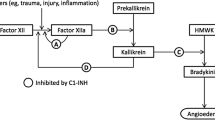Abstract
Icatibant is a selective antagonist of the bradykinin type 2 receptor.
In the randomized, double-blind, multicentre, FAST-1 trial, the difference in the median time to the onset of symptom relief (primary endpoint) did not reach statistical significance between a single dose of subcutaneous icatibant 30 mg and placebo in adults with moderate to very severe acute abdominal or cutaneous episodes of hereditary angioedema. However, icatibant was effective with regard to several other endpoints, providing significantly greater reductions from baseline in symptom severity scores 4 and 12 hours after administration, and eliciting significantly shorter times to both first symptom improvement and overall patient improvement than placebo.
In the similarly designed, active comparator-controlled, FAST-2 trial, a single dose of subcutaneous icatibant 30 mg was associated with a significantly shorter median time to onset of symptom relief (primary endpoint) than oral tranexamic acid in adults with acute abdominal or cutaneous episodes of hereditary angioedema, and was also more effective than tranexamic acid in terms of most other endpoints.
Across both FAST-1 and -2, the efficacy of subcutaneous icatibant 30 mg in the treatment of laryngeal episodes of hereditary angioedema was generally consistent with that seen for abdominal and cutaneous episodes, with a median time to first symptom improvement of 0.6–1.0 hours.
Subcutaneous icatibant was generally well tolerated in adult patients with hereditary angioedema in the FAST trials, with the most common adverse events being injection-site reactions that were generally of mild severity, transient in nature and resolved spontaneously without treatment.


Similar content being viewed by others
References
Bowen T, Cicardi M, Bork K, et al. Hereditary angiodema: a current state-of-the-art review, VII — Canadian Hungarian 2007 international consensus algorithm for the diagnosis, therapy, and management of hereditary angioedema. Ann Allergy Asthma Immunol 2008 Jan; 100 (1 Suppl. 2): S30–40
Reshef A, Leibovich I, Goren A. Hereditary angioedema: new hopes for an orphan disease. Isr Med Assoc J 2008 Dec; 10(12): 850–5
Davis AE. New treatments addressing the pathophysiology of hereditary angioedema. Clin Mol Allergy 2008 Apr 14; 6 (2)
Zuraw BL. Hereditary angioedema. New Eng J Med 2008 Sep 4; 359(10): 1027–36
Longhurst HJ. Emergency treatment of acute attacks in hereditary angioedema due to C1 inhibitor deficiency: what is the evidence? Int J Clin Pract 2005 May; 59(5): 594–9
Cugno M, Cicardi M, Bottasso B, et al. Activation of the coagulation cascade in C1-inhibitor deficiencies. Blood 1997 May 1; 89(9): 3213–8
Gompels MM, Lock RJ, Abinun M, et al. C1 inhibitor deficiency: consensus document [published erratum appears in Clin Exp Immunol 2005; 141 (1): 189–90]. Clin Exp Immunol 2005; 139(3): 379–94
Frank MM, Jiang H. New therapies for hereditary angioedema: disease outlook changes dramatically. J Allergy Clin Immunol 2008 Jan; 121(1): 272–80
Jerini AG. Firazyr 30mg solution for injection in pre-filled syringe: summary of product characteristics [online]. Available from URL: http://www.emea.europa.eu/humandocs/PDFs/EPAR/firazyr/emea-combined-h889en.pdf [Accessed 2009 Sep 24]
Hock FJ, Wirth K, Albus U, et al. Hoe 140 a new potent and long acting bradykinin-antagonist: in vitro studies. Br J Pharmacol 1991; 102: 769–73
Wirth K, Hock FJ, Albus U, et al. Hoe 140 a new potent and long acting bradykinin-antagonist: in vivo studies. Br J Pharmacol 1991; 102: 774–7
Han ED, MacFarlane RC, Mulligan AN, et al. Increased vascular permeability in C1 inhibitor-deficient mice mediated by the bradykinin type 2 receptor. J Clin Invest 2002 Apr; 109(8): 1057–63
Cockcroft JR, Chowienczyk PJ, Brett SE, et al. Inhibition of bradykinin-induced vasodilation in human forearm vasculature by icatibant, a potent B2-receptor antagonist. Br J Clin Pharmacol 1994; 38: 317–22
Brown NJ, Gainer JV, Murphey LJ, et al. Bradykinin stimulates tissue plasminogen activator release from human forearm vasculature through B2 receptor-dependent, NO synthase-independent, and cyclooxygenase-independent pathway. Circulation 2000 Oct 18; 102(18): 2190–6
European Medicines Agency. CHMP assessment report for Firazyr [online]. Available from URL: http://www.emea.europa.eu/humandocs/PDFs/EPAR/firazyr/H-899-en6.pdf [Accessed 2009 Sep 23]
Wagner F, Rosenkranz B, Knolle J. Absolute bioavailability of subcutaneously administered icatibant, a selective and potent bradykinin B2 receptor antagonist [abstract no. 1071]. J Allergy Clin Immunol 2007 Jan; 119 (1 Suppl.): S274
Bork K, Frank J, Grundt B, et al. Treatment of acute edema attacks in hereditary angioedema with a bradykinin receptor-2 antagonist (icatibant). J Allergy Clin Immunol 2007 Jun; 119(6): 1497–503
Riedl M. Icatibant, a selective bradykinin B2 receptor antagonist, proves effective and safe in treating the symptoms of hereditary angioedema (HAE) attacks [abstract no. 398]. J Allergy Clin Immunol 2008 Feb; 121(2): S103
Malbran A. Successful treatment of 103 attacks of hereditary angioedema (HAE) with bradykinin B2 receptor antagonist icatibant [abstract no. 395]. J Allergy Clin Immunol 2008 Feb; 121(2): S102
US National Institutes of Health. Providing information regarding some clinical trials that are completed. [online]. Available from URL: http://www.clinicaltrials.gov [Accessed 2009 Sep 25]
Staubach P, Bork K. Safety evaluation of icatibant, a selective bradykinin B2 receptor antagonist used in hereditary angioedema due to C1 inhibitor deficiency [abstract no. 376]. J Allergy Clin Immunol 2009 Feb; 123 (2 Suppl.): S100
Acknowledgements and Disclosures
The manuscript was reviewed by: K. Bork, Department of Dermatology, Johannes Gutenberg University, Mainz, Germany; H. Longhurst, Department of Immunology, Barts and the London NHS Trust, Whitechapel, London, UK.
The preparation of this review was not supported by any external funding. During the peer review process, the manufacturer of the agent under review was offered an opportunity to comment on this article. Changes resulting from comments received were made on the basis of scientific and editorial merit.
Author information
Authors and Affiliations
Corresponding author
Rights and permissions
About this article
Cite this article
Deeks, E.D. Icatibant. Drugs 70, 73–81 (2010). https://doi.org/10.2165/11204500-000000000-00000
Published:
Issue Date:
DOI: https://doi.org/10.2165/11204500-000000000-00000




